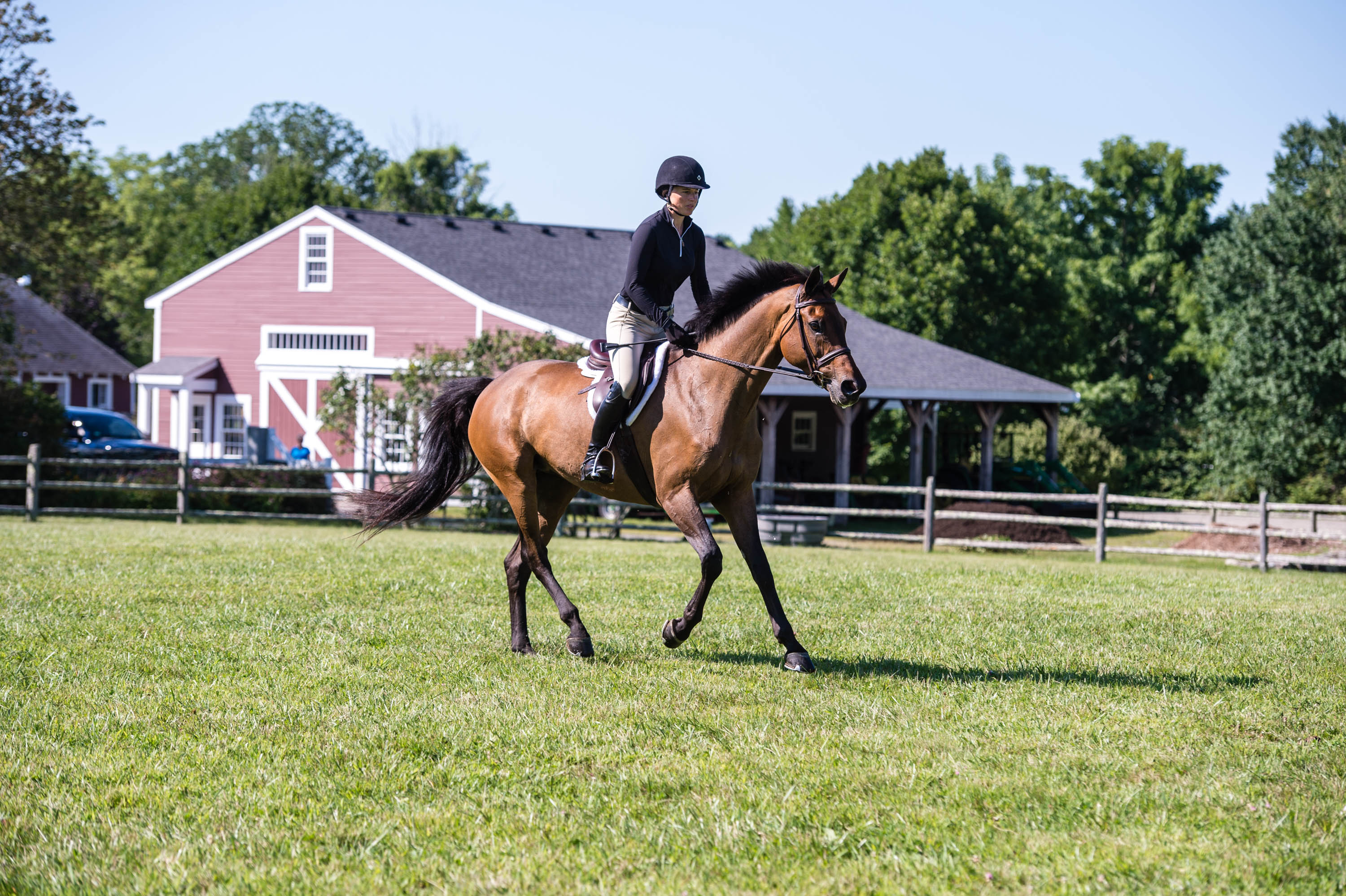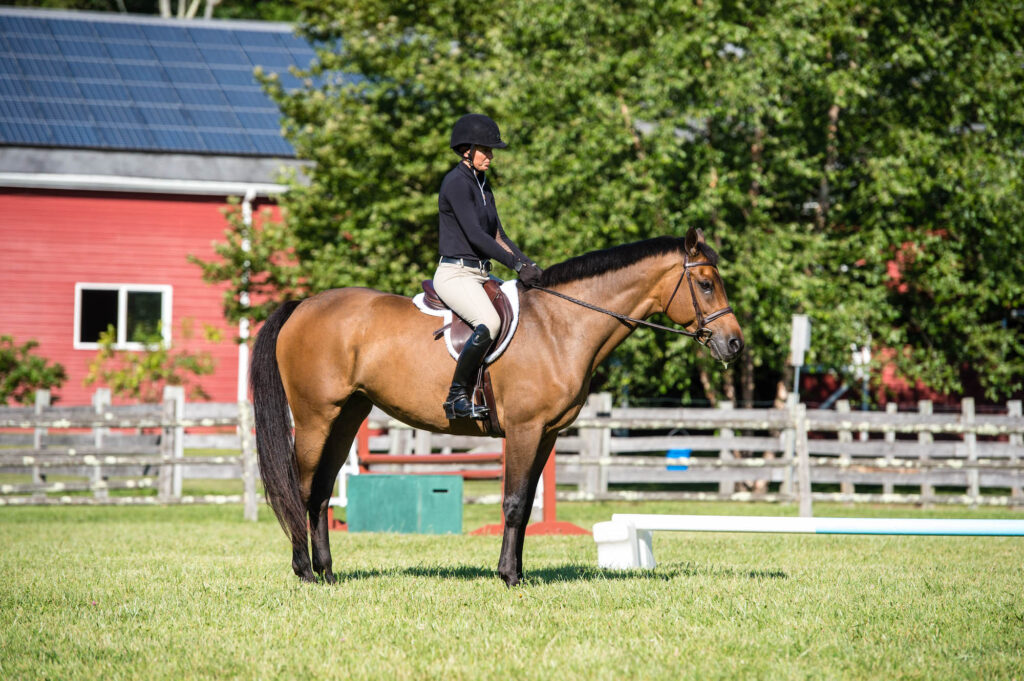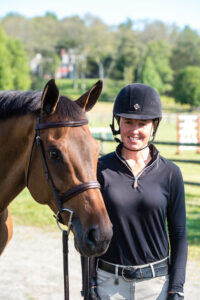
One of the most common problems I see juniors and adult amateurs struggle with on course is maintaining a consistent pace. Everyone’s goal should be to finish the round with the same pace they had when they started—but that’s easier said than done. Eight times out of 10, riders start too slow and end too fast. Some start at a decent pace but then slow down midway through and never gear up again.
Having an inconsistent pace not only destroys the nice flow the judge is looking for, but it also interferes with your ability to find the distances to the jumps. If you approach each fence in a reliable working canter—the canter that hunter courses are generally set for—you’ll have three options for meeting the correct takeoff spot: maintaining your current pace, moving up or waiting. If you approach the jump either too slowly or too quickly, that narrows your options. For example, if you’re going too fast, you’ll arrive at the jump at the end of your horse’s stride—the biggest stride he can make comfortably—which means you’ll have only two options: Either you’ll arrive at the fence on a very long, flat distance or you’ll be forced to shorten his stride at the last minute and get to a too-deep takeoff spot.
Focusing on pace rather than distances actually makes finding those distances easier. When riders worry about finding distances, they tend to get tense and too busy with their hands. When they focus on their pace instead, they relax and get quieter in their horses’ mouths. As a result, the jumps seem somewhat secondary—and the distances work out.
That doesn’t mean you should stay at the exact same pace all the way around the course. After each jump your speed needs to slow temporarily as you and your horse recover your balance. However, some people wait too long to return to the working canter in time for a good approach to the next jump. The sooner you get back to your go-to show pace, the better. The following exercises will help you do that.
Recognize Different Speeds
Before you can control your pace consistently you need to be able to identify your horse’s different speeds. To do that, I like to use a technique for building a mental speedometer that I first learned from George Morris. Think of your horse’s speeds as if they’re miles per hour. They don’t have to actually be accurate miles-per-hour speeds—for example, your “6 mph” doesn’t have to be truly 6 mph. It just helps to remember them this way.
Use a range from 0 to 10 mph, with 0 being a halt and 10 being a hand gallop. Anything beyond a 10 is an out-of-control speed that you’d probably rather avoid. Familiarize yourself with each speed on the flat, starting at the halt and working your way through each individual speed all the way up to a 9 or 10, if you’re comfortable doing that, and then working your way back down to 0. So:
1 mph is a normal walk
2 mph is a working walk
3 is a collected trot
4 is a working trot
5 is a lengthened trot
6 is a very collected canter
7 is a medium canter
8 is a working canter (usually your go-to speed in the show ring)
9 is a lengthened canter but not quite a hand gallop
Note: In the story and photo captions, I use common hunter/jumper terms to describe variations in pace, some of which might have different meanings in other disciplines. For example, my medium canter is not as forward as a medium canter in a dressage or event rider’s “speedometer.”
As you shift gears through the speeds, constantly ask yourself, “What speed am I going?” Especially within gaits, try to define distinct differences between each speed. In the canter, for example, a 6 should feel more collected than a 7, and a 7 should feel a little more comfortable than an 8, which should feel a bit stronger; a 9 should feel clearly more forward than an 8.
For the upward transitions both within and between gaits, close your legs, lift your seat slightly out of the tack and follow your horse’s mouth with your hands. For the downward transitions, sit down in the saddle, deepen your heels and hold a little more weight in your hands. As soon as your horse responds by slowing down, lighten the pressure on the reins. This will encourage him to maintain the new pace on his own.









Maintain Different Speeds
Once you start to recognize the different speeds, the next step is to learn how to maintain them. After identifying each speed, ask yourself, “Can I keep it?” Practice maintaining each speed for a while before changing it. Do you find your 8 gradually creeping up to a 9 or slowing down to a 7? Recognizing either tendency—which often happens completely unconsciously—will be valuable later on when you plan your course strategies.
It helps to have someone on the ground to assist you with identifying these different speeds, but you can learn to do it on your own, too. It just takes plenty of repetition.
After you’ve run your speedometer up and down several times, put it to the test. Find your 8 canter, then see if you can go from that to a 6, then see if you can do a 9. Play with different speeds until you start to recognize exactly what it takes—and how long it takes—to get from one to another. For example, how long does it take to get from 9 to 7? Ideally, each transition should be crisp, taking just one or two strides to complete.
If your horse is on the lazy side, practice lots of upward transitions. Be sure to get him responsive to your leg by following it up with your spur whenever necessary. When he doesn’t respond to that, add a cluck. When that doesn’t work, use your whip behind your leg. If he’s chronically slow to respond, pick a point ahead of you on the long side of the ring and plan to get up to 9 mph by that point. Then use all your driving aids together—leg, spur, cluck and whip—to get to that pace by that point. After you pass it, maintain the 9 around the corner before asking for a downward transition. (If you’re riding in a small arena with tight corners, ride the 9 only on the straightaway. Then slow down to an 8 or 7 for the corner.)
On the other extreme, if you have a hotter horse whose speed tends to build over time, practice plenty of downward transitions: walk to halt, trot to halt, canter to walk, etc.
As you practice making transitions between speeds, use visual aids around your ring—dressage letters, fence posts, marks on the wall, etc. Then challenge yourself by planning to reach certain speeds at particular spots. For example, find your 8 canter on the right lead and plan to ask for a 7 between letters A and K. Or pick two fence posts and plan to ride five strides at 7 mph, starting and finishing at 9 mph. Begin with transitions you find easy, then gradually test yourself with harder ones.
Pace Yourself on a Turn
Once you can recognize your different canter speeds, set up two ground poles or cavalletti on the long sides of the arena, directly across from one another (see the diagram below). Then plan to ride over the poles as if they were jumps, making a nice turn in between them. Imagine that the poles are at the 3 and 9 o’clock positions on a clock and the tops of your turns between them are at noon and 6 o’clock. It doesn’t matter what shape the turns are—they can be either round like half circles or more oval-shaped.

Approach the first pole in your 8 canter. Keep that pace until you see your distance to the pole. Then either maintain it if the distance looks correct or adjust your canter slightly to meet the pole comfortably—either notching down to a 7 for a tighter distance or notching up to a 9 for a longer distance. After the pole, immediately sink down in your seat and heels and lift your hands and eyes, asking your horse to come back to 7 mph. This is your recovery pace.
As you enter the turn, be ready to move back up to an 8 by the time you reach the top of it, which would be at 6 o’clock if you began on your right lead over the 3 o’clock jump. By maintaining that 8, you’ll come nicely forward out of the turn, ready to approach the second pole in the same manner that you used over the first. (If you’re on a young horse, it’s OK to come back to trot as you begin the turn after the first pole, then pick up the canter and find your 8 again before you exit the turn.)
Repeat the same method over the second pole, adjusting as necessary for the takeoff, then gearing down to 7 mph in the recovery and returning to 8 by the top of the next turn. Make your first priority getting to the right speeds at the right places. Your second priority is your position. Generally, most riders tip ahead of the motion on landing. Be sure to get back into the saddle as soon as possible after each pole. Otherwise, whenever you have time to think about it, ask yourself, “Do I feel strong in my core? Am I tall in my body? Are my hands quiet?” If you have a ground person, ask her to give you feedback both on your speed and how your position looks at different moments in the exercise.
When this is going well, replace the poles with jumps and repeat the exercise the same way. As you do so, try to identify the most difficult parts of the turn. Every horse is different. Some are harder to bring back to the 7 in the recovery phase; others take extra urging to return to 8 by the top of the turn. Arming yourself with this knowledge about your horse’s particular tendencies is an invaluable building block for riding courses successfully.






Control Your Pace on Course
The next step is to practice these skills on a simple hunter course of single fences on long approaches and flowing lines (see photos below). Remember to start with your 8 canter and return to it as soon as possible after every jump recovery, always before the top of every turn. If you wait to find your 8 until you come out of the turn and straighten, it’ll be too late. Ideally, you want to be at 8 before and after each line as well, but you may need to adjust that slightly for the takeoff of the fence. If you jump in at 7, try to move back up to 8 quickly. If you jump in at 9, try to steady back to 8.
To help yourself monitor your pace around the course, say the number out loud each time you change speeds. In the approaches, find your 8 and say it out loud. When you reach 7 in the recovery, say it. At the top of each turn, confirm out loud that you’re back to your go-to 8.
When you’re comfortable controlling your pace on this basic course, move on to more technical courses. You’ll find these skills useful on equitation, handy-hunter and jumper courses. With some tight jumper turns and rollbacks, you might not have time to get back up to your 8 for the next jump, but you’ll still need to recover from the last jump right away—getting your weight off your horse’s neck, looking ahead to the next jump and slowing down before the turn.
At horse shows, because you’ve done your homework, you’ll know what parts of the course you’ll need to focus on. Riders think they have so much time on course, but the next element on course happens much faster than you expect. With your new speedometer, you’ll always have the canter you need—and you’ll start and finish at the same pace.







About Kristy Herrera

Kristy McCormack won the 2002 U.S. Equestrian Federation Show Jumping Talent Search Finals before riding professionally for top riders Jen Alfano, Beezie Madden, Nona Garson and Aaron Vale and spending a year riding for Stephex Stables in Belgium, where she won several grand prix classes. For the next five years, she assisted Missy Clark in training numerous national equitation champions, including her sister, Kimmy McCormack, who won both the 2007 Pessoa/USEF National Hunter Seat Medal Final and the 2007 ASPCA Maclay National Championship. In 2016, Kristy filled in for Jen Alfano while she was sidelined with an injury and won the USHJA International Hunter Derby Championship that year riding Helen Lenehan’s Miss Lucy. Kristy currently resides in Saratoga Springs, New York, and spends her time freelancing as a rider and clinician. She also is cohosting The Show Jumping Podcast.
This article was originally published in the March 2018 issue of Practical Horseman.

